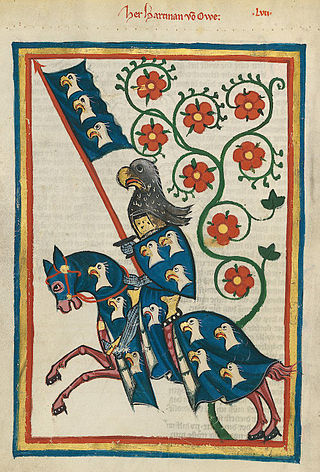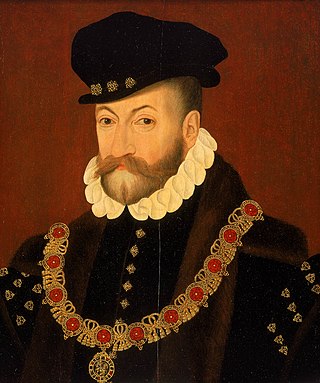Related Research Articles

A knight is a person granted an honorary title of knighthood by a head of state or representative for service to the monarch, the church or the country, especially in a military capacity.
In the United Kingdom and the British Overseas Territories, personal bravery, achievement, or service are rewarded with honours. The honours system consists of three types of award:

The Most Excellent Order of the British Empire is a British order of chivalry, rewarding contributions to the arts and sciences, work with charitable and welfare organisations, and public service outside the civil service. It comprises five classes of awards across both civil and military divisions, the most senior two of which make the recipient either a knight if male or a dame if female. There is also the related British Empire Medal, whose recipients are affiliated with, but not members of, the order.
Sir is a formal honorific address in English for men, derived from Sire in the High Middle Ages. Both are derived from the old French "Sieur" (Lord), brought to England by the French-speaking Normans, and which now exist in French only as part of "Monsieur", with the equivalent "My Lord" in English.

The Most Honourable Order of the Bath is a British order of chivalry founded by King George I on 18 May 1725. Recipients of the Order are usually senior military officers or senior civil servants, and the monarch awards it on the advice of His Majesty's Government. The name derives from an elaborate medieval ceremony for preparing a candidate to receive his knighthood, of which ritual bathing was an element. While not all knights went through such an elaborate ceremony, knights so created were known as "knights of the Bath".

The Most Distinguished Order of Saint Michael and Saint George is a British order of chivalry founded on 28 April 1818 by George, Prince of Wales, while he was acting as prince regent for his father, King George III. It is named in honour of two military saints, Michael and George.

The New Zealand Order of Merit is an order of merit in the New Zealand royal honours system. It was established by royal warrant on 30 May 1996 by Elizabeth II, Queen of New Zealand, "for those persons who in any field of endeavour, have rendered meritorious service to the Crown and nation or who have become distinguished by their eminence, talents, contributions or other merits", to recognise outstanding service to the Crown and people of New Zealand in a civil or military capacity.
The order of precedence in Scotland was fixed by Royal Warrant in 1905. Amendments were made by further Warrants in 1912, 1952, 1958, 1999 and most recently in 2012.
An unofficial order of precedence in Northern Ireland, according to Burke's Peerage, 106th Edition, this is not officially authorised by or published with authority from either Buckingham Palace or the College of Arms, or the Home Office, the Ministry of Justice or the Northern Ireland Office (NIO) of His Majesty's Government in the United Kingdom, or the Northern Ireland Assembly, or the Northern Ireland Executive.

The Most Venerable Order of the Hospital of Saint John of Jerusalem, commonly known as the Order of St John, and also known as St John International, is an order of chivalry constituted in 1888 by royal charter from Queen Victoria and dedicated to St John the Baptist.

The Royal Victorian Order is a dynastic order of knighthood established in 1896 by Queen Victoria. It recognises distinguished personal service to the monarch, members of the royal family, or to any viceroy or senior representative of the monarch. The present monarch, King Charles III, is the sovereign of the order. The order's motto is Victoria. The order's official day is 20 June. The order's chapel is the Savoy Chapel in London.

The Most Exalted Order of the Star of India is an order of chivalry founded by Queen Victoria in 1861. The Order includes members of three classes:
- Knight Grand Commander (GCSI)
- Knight Commander (KCSI)
- Companion (CSI)

Grand Cross is the highest class in many orders, and manifested in its insignia. Exceptionally, the highest class may be referred to as Grand Cordon or equivalent. In other cases, there may exist a rank even higher than Grand Cross, e.g. Grand Collar. In rare cases, the insignia itself is referred to as the "grand cross".
A rosette is a small, circular device that is typically presented with a medal. The rosettes are either worn on the medal to denote a higher rank, or for situations where wearing the medal is deemed inappropriate, such as on a suit. Rosettes are issued to those awarded a knighthood or damehood in a chivalric order, as well as state orders in nations such as Belgium, France, Italy and Japan, among others. Certain hereditary societies, such as the Society of Descendants of the Latin Kingdom of Jerusalem, as well as some fraternal orders issue rosettes to their members as well.
The orders, decorations, and medals of Canada comprise a complex system by which Canadians are honoured by the country's sovereign for actions or deeds that benefit their community or the country at large. Modelled on its British predecessor, the structure originated in the 1930s, but began to come to full fruition at the time of Canada's centennial in 1967, with the establishment of the Order of Canada, and has since grown in both size and scope to include dynastic and national orders, state, civil, and military decorations; and various campaign medals. The monarch in right of each Canadian province also issues distinct orders and medals to honour residents for work performed in just their province. The provincial honours, as with some of their national counterparts, grant the use of post-nominal letters and or supporters and other devices to be used on personal coats of arms.

An order of chivalry, order of knighthood, chivalric order, or equestrian order is an order of knights, typically founded during or inspired by the original Catholic military orders of the Crusades and paired with medieval concepts of ideals of chivalry.
Commander, or Knight Commander, is a title of honor prevalent in chivalric orders and fraternal orders.

The Pontifical Equestrian Order of Saint Sylvester, sometimes referred to as the Sylvestrine Order, or the Pontifical Order of Pope Saint Sylvester, is one of five orders of knighthood awarded directly by the Pope as Supreme Pontiff and head of the Catholic Church and as the Head of State of Vatican City. It is intended to honour Catholic laypeople who are actively involved in the life of the Church, particularly as it is exemplified in the exercise of their professional duties and mastership of the different arts.

A collar, also known as collar of an order, is an ornate chain, often made of gold and enamel, and set with precious stones, which is worn about the neck as a symbol of membership in various chivalric orders. It is a particular form of the livery collar, the grandest form of the widespread phenomenon of livery in the Middle Ages and Early Modern Period. Orders which have several grades often reserve the collar for the highest grade. The links of the chain are usually composed of symbols of the order, and the badge of the order normally hangs down in front. Sometimes the badge is referred to by what is depicted on it; for instance, the badge that hangs from the chain of the Order of the Garter is referred to as "the George".

The Royal Order of Isabella the Catholic is a knighthood and one of the three preeminent orders of merit bestowed by the Kingdom of Spain, alongside the Order of Charles III and the Order of Civil Merit. It recognizes extraordinary services to the homeland or the promotion of international relations and cooperation with other nations, with a particular focus on the territories of the former Spanish Empire. By law, its Grand Master is the King of Spain, and its Grand Chancellor is the Minister of Foreign Affairs. The Order is open to both Spaniards and foreigners, particularly from the Spanish-speaking world.
References
- 1 2 3 Dorling, H. Taprell (1956). Ribbons and Medals. London: A. H. Baldwin & Sons. pp. 16, 28–36. OCLC 930416375.
- 1 2 Hieronymussen, Paul (1970). Orders, medals, and decorations of Britain and Europe in colour. London: Blandford Press. pp. 29, 224. ISBN 978-0-7137-0445-7.